Screening is the passing of material through definite and uniform apertures is the only true and accurate means of grading to a required particle size. Air separation and hydraulic classification depend upon gravity and particle shape, and result in the segregation and retention of material of higher specific gravity and lower surface area irrespective of size.
The use of Screens increases with the education and civilization of a people and with the improving and perfecting of an art. In our advanced civilization practically everything that we eat, wear and use has been in contact with, or dependent upon screens in some phase of its growth, development or processing. In this treatise, we are only concerned with the sorting, grading or sizing as accomplished with a mechanical screening device.
Some materials such as beach sands, clays, native chemicals, etc., occur in nature in a closely graded state resulting from a mechanical water sorting, precipitation or gravity deposition. They require only scalping or some form of treatment for removal of tramp coarse foreign elements. Others such as salt, sugar and various chemicals are crystallized or precipitated in their processing to fairly close limits of size. They require only such sorting or grading as is dictated by market preference and conditions of use.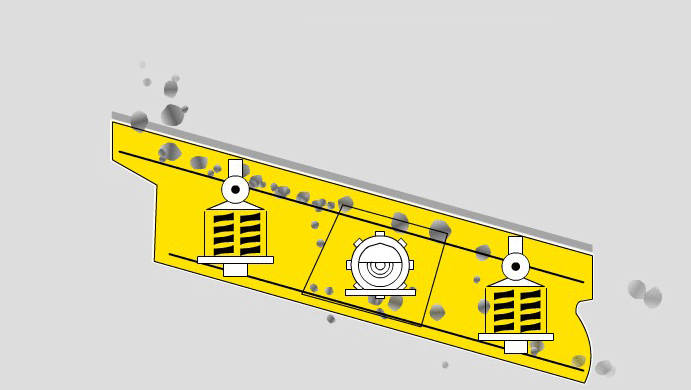
In mechanical mixtures such as raw cement, finished fertilizers, stock feeds, etc., the ingredients are blended, ground and screened to a definite fineness. This maintains the intimate relationship by preventing segregation of a coarse constituent through automatic sorting. We have all noted how by piling an ungraded material the fines will segregate in the center of the pile and the coarse will automatically run to the outside and bottom. Metallic and non-metallic ores, stone and other aggregates, coal and coke, various furnace products, chemicals, cereals etcetera, must be crushed, ground, disintegrated or pulverized before they can go on to further processing and ultimate use. In these fields screens are used for sorting into definite grades, top scalping for removal of coarse oversize and foreign material, bottom scalping for elimination of fines and dirt, and to return oversize to a crusher or grinder until it is reduced to a size finer than the opening of the screen. This latter practice is known as “closed circuit” crushing or grinding.
Testing sieves are of the utmost importance in analysing a screening problem or checking the performance of a crusher or grinder.
A nest of standard brass framed screens, with a definite ratio between openings, is used to sort a representative sample into the clean fractions retained on each screen. The tabulated resulting sieve analysis graphically shows the percentages of given sizes present in the sample. (Table I, p. 347). It indicates just what is available for recovery by screening through and over certain openings in a commercial production screening operation and also shows the reduction obtained by passage through crusher or grinding mill.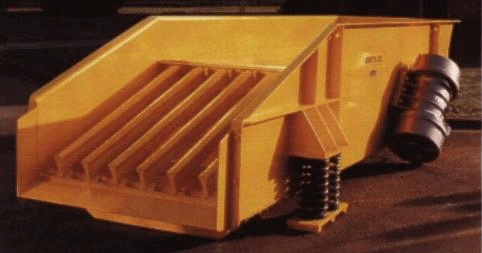
Another important factor in commercial screening that will be revealed by a sieve analysis is the percentage of “near-mesh” material present in the screen feed. If, for instance, it is observed that 40 percent of the sample had passed through the 8-mesh testing screen and was retained on 10- mesh and another 40 percent had passed through 10-mesh and was retained on 14-mesh, an efficient production screening operation at 10-mesh would require the maximum in screen area, particularly as to length. This preponderance of near-mesh, or “go and no-go” size of particle, obviously makes a difficult separation condition. In such cases unless the proper care is taken in the selection of the type of screening device and the specification of the wire cloth used on it, the openings may fill up and blind to a point where no separation is obtained.
In addition to the necessary sieve analysis, other factors must be known before a proper and intelligent recommendation can be made on any but the simplest of screening problems. Many cases require a laboratory test, simulating actual operating conditions, before the size and type of the screen can be determined and proper specification of screen cloth selected. The screen “doctor” must have the answer to the following questions before he can make proper diagnosis and prescribe treatment:
Kind of material and weight per cubic foot? This will indicate bulk to be handled and, from past experience, suggest treatment for special conditions possibly not revealed by other data.
Capacity required in tons or gallons per hour? This should be expressed in both average and maximum, because peak loads, even of short duration, may result in spoiling of products previously graded or may upset subsequent steps in the operation, due to the drop in screening efficiency. Sufficient screen area should be provided to handle the maximum load.
Type of screening, wet or dry? How much water can be added? In the case of wet screening it is necessary to know if a definite density of the through screen product must be maintained and how much spray water can be added to rinse the oversize.
Percentage of moisture present in the feed? The maximum figure should be given here because different materials become unscreenable at varying degrees of moisture. To effect a separation at a given fineness it may be necessary to dry the material or add water and wash it through the screen.
Temperature in degrees Fahrenheit? This concerns hot products such as sinter, furnace slags, stucco, etc., where rubber parts, bearings or screen cloth might be affected by high temperature.
Is material free-screening? An affirmative answer here obviates practically all other questions.
Sticky? As clay, some food products, chemicals, etc. This determines if screening is practical and type of wire cloth recommended.
Hygroscopic? As certain salts and chemicals which absorb atmospheric moisture. Reasons same as above.
Agglomerative? As some oxides and chemicals through static or other conditions. If material has a tendency to collect and ball-up, means will be provided to overcome the condition.
Friable? Example, coal, crystalline products, etc., where for economic reasons, breakage must be minimized.
Abrasive? This condition determines size and properties of wire to be used in screen cloth and necessity for wearing plates in the screen body and accessory chutes and hoppers.
Corrosive? Indicates alloys to be used in contacting parts.
Granular, slivery or flaky? These questions are grouped since the answers show whether square-mesh or elongated-opening wire cloth can be used.
Dusty? If so, covers and complete dust enclosures are recommended.
Type and setting of primary crusher and secondary crusher? This information indicates size and shape of screen feed. It may be means of constructive suggestion on crushing balance and economy.
Is oversize re-crushed and if so, percentage of circulating load? This is vital information and should always be supplied.
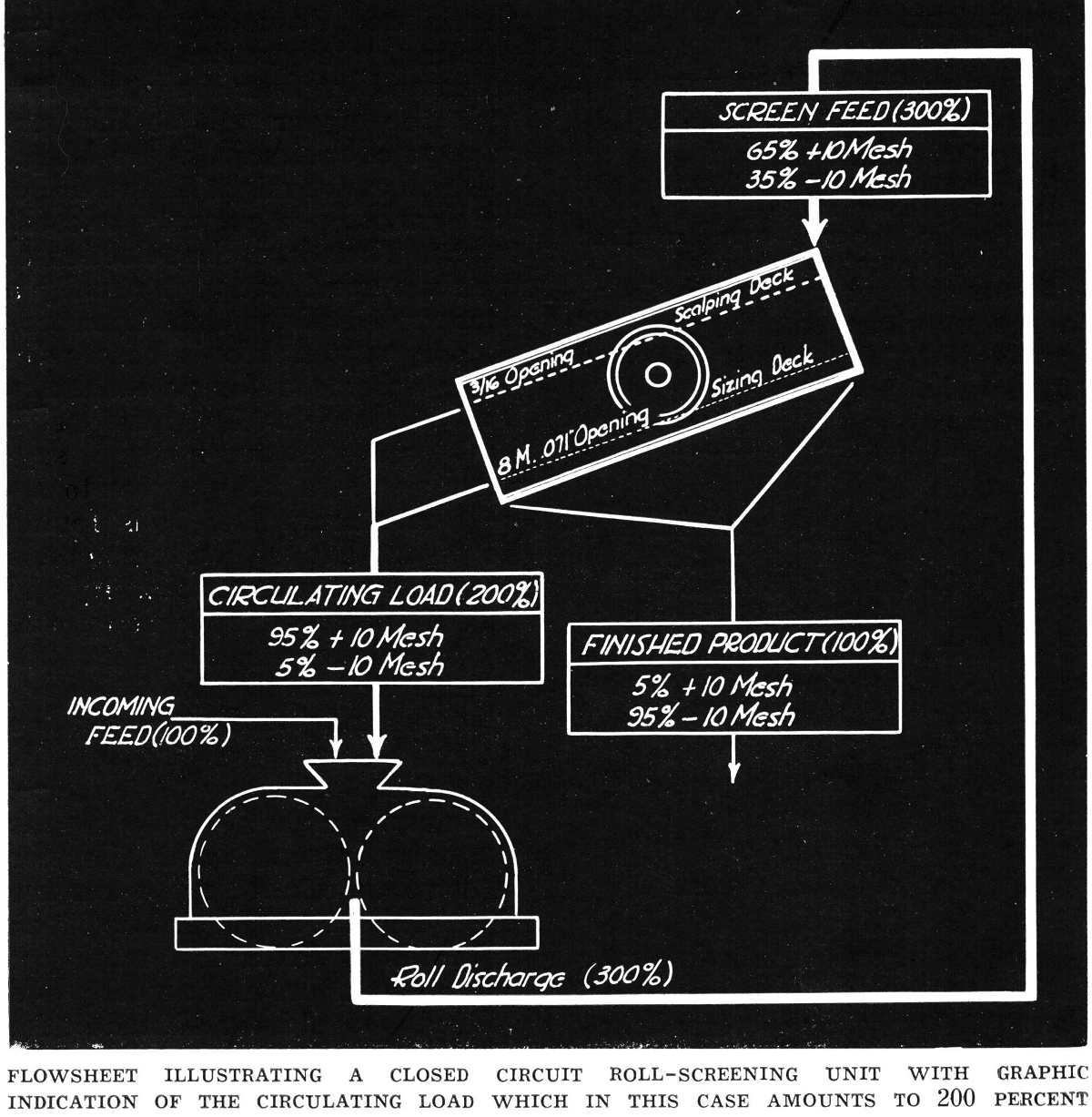
Closed Circuit Screening
By “closed circuit” crushing or grinding it is meant that the product from a crusher or grinder is fed to a screen. The material that has been reduced to sufficient fineness passes through the openings and the oversize is returned to the breaker for further reduction. Escape from the circuit can only be through the screen so this product, the undersize, is equal in tonnage to the initial feed to the crusher or mill. The oversize returned for further work is known as the circulating load. It is a most important factor and can be extremely insidious. If the screen is inefficient and rejects finished material or if the crusher will not reduce the oversize fast enough, this load may build up, and rapidly, to a point beyond the capacity of the breaker, the screen or the conveying equipment, whichever proves to be the neck of the bottle.
For greatest economy and efficiency, fines should be removed by means of a screen just as fast as they are created in each successive stage of crushing or grinding. Most every case must be handled on its own individual merits and proper balance worked out. In some cases a circulating load as high as 1,000 percent is considered economical. Picture how this would affect the requirement in screening capacity with eleven tons of material handled for every ton produced.
The percentage of circulating load can be readily determined from the sieve analyses of the screen feed, the oversize and the undersize (See Table 1). Samples should be taken simultaneously after circulating load has reached its peak. Conditions and analyses will be similar to those set forth in flowsheet at right. The formula can be expressed:
Percent Circulating Load=100 (B-C/A-C -1)
A=Percent finer than required size in the screen feed.
B=Percent finer than required size in the screen undersize.
C=Percent finer than required size in the screen oversize.
In the example, “A” equals 35.0, “B” equals 95.0, and “C” equals 5.0. The value of “1” in the formula represents the initial feed
to the circuit which is equivalent to the undersize, or product removed through the screen.
The equation becomes:
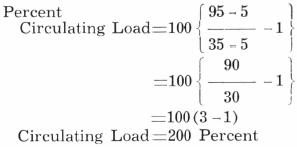
This means that for every one ton of material produced, the screen is fed three tons and two tons are returned to the crusher in the form of a circulating load.
Calculate Screen Efficiency
While discussing formulae, it may be of interest to note a simple computation for screen efficiency. This formula is:
Percent Efficiency=100(100 F-D/AF)
A=Percent finer than required size in the screen feed.
D=Percent coarser than required size in the screen feed.
F =Percent coarser than required size in the screen oversize.
Assuming the same analyses as in the previous calculation, “A” equals 35.0, “D” equals 65.0 and “F” equals 95.0. Thus:
Percent Efficiency=100(100 (95-65)/35×95)
=100 (3000/3325)
Efficiency=90.22 Percent
There are different schools of thought on this subject and other formulae. Some operators are satisfied to simply use the percentage coarser than the screen opening in the overscreen product as the efficiency figure. This would be “F” in the above formula and 95 percent instead of 90.22 percent.
Screen Panel Selection
Dependent on the nature of the material and type of operation, screening may be accomplished through bars, perforated plate or woven wire screen. The bar screen is used for scalping extremely coarse material where definite sizing is of secondary importance and abrasion is severe. Perforated plate offers a smooth surface upon which heavy oversize will slide very easily, often too easily for good screening. Under some conditions it blinds less readily than woven wire screen. Objections to it are the fact that the openings wear gradually larger and larger, and the percentage of blank area is so high.
For most purposes woven wire screen, or wire cloth, is the best medium. With it the maximum in open area can be obtained. Various weights, metals and alloys, and shapes of openings are available to satisfy conditions of heavy load, abrasion, corrosion, screenability and capacity. “Mesh” in wire cloth is the number of openings per lineal inch and means nothing unless accompanied by the decimal designation of the wire diameter or the actual opening of the screen. It is best to specify the required screen opening as this can then be obtained in several meshes, dependent upon the weight of wire that is used. Obviously, for a given opening, the greater the mesh count and the finer the wire diameter, the higher will be the percentage of open area in the fabric.
Much as we might like to do so, we cannot have our cake and eat it, too. Therefore, the selection of a screen specification is usually a compromise. Dependent upon conditions, screen life is constantly being sacrificed for screenability and vice versa. For instance, a heavy and abrasive material suggests an extra heavy wire to secure maximum life. It is found, however, that the low percentage of open area restricts capacity and that the large wire diameter promotes blinding and lowers efficiency. A compromise is, therefore, made by easing off on the weight of the wire. Conversely, another material may, for instance, be damp and sticky, dictating the use of an extremely fine diameter of wire to minimize the surface upon which it may build up. Such a screen specification may last only a few hours and capacity and efficiency must be sacrificed in the interest of longer screen life.
Rectangular and elongated screen openings assist greatly in increasing capacity and eliminating blinding. The opening in a square mesh screen is shaped similar to a funnel and particles can be wedged into it to bear on all four sides. The rectangular opening limits this contact to three sides and thus minimizes the possibility of wedge blinding. When this slot is further elongated to many times the opening width, a springing of the long wires is possible and permanent blinding is eliminated. Naturally, these long openings can not be used for true sizing of anything but cubical or granular materials. Where flakes and slivers are present and cannot be tolerated in the screen under-size, square mesh cloth must be used at the sacrifice of capacity.
For abrasion resistance, high- carbon spring steel wire is available. Stainless steel and the non- ferrous alloys give a selection where rust and corrosion are a factor. The difference between success and failure of a screening operation may rest with the selection of the proper screen cloth specifications and this subject requires considerable thought and study, plus experience.
Vibrating Screen Capacity
Reviewing the foregoing, it is readily understandable that a fixed table of screen capacities would be misleading and dangerous. There are so many variables that two neighbouring plants, working on the same deposit, may have entirely different screening conditions, due, for instance, to a difference in crushing practice. Larger tonnages can be handled on scalping operations, and in some cases with closed circuit crushing, than on close grading into specific fractions. On some materials a scalping deck over the sizing screen increases capacity by breaking and distributing the load and opening- up the mat of material. Washing increases capacity materially over so-called dry screening.
Screening Equipment Selection
From the grizzly and trommel we have seen the development of screening devices through the shaking, knocking and bumping stages to the high speed vibrating screen of today. This development ran the range of eccentric head motions; knockers; cams; air, cam and electric vibrators; unbalanced shafts and eccentric flywheels; grasshopper motions, etc., up to the present positive-drive, high-speed, circle-throw, eccentric- shaft screen.
In this type the throw and speed must be properly specified and coordinated to secure the best screening action. Bearings should not be under shock and design should not be complicated with compensators and adjustments to eat power and tempt experimentation. The loading of the bearings should be so minimized that the equipment manufacturer evidences his confidence in his design by extending a generous guarantee.
In closing, it is recommended that the screen user select a proved and simple machine that will give uniform, continuous, care-free operation. Your supplier should qualify to consult with you on installation, operation, and selection of proper screen cloth specifications. Do not overlook this important service feature.
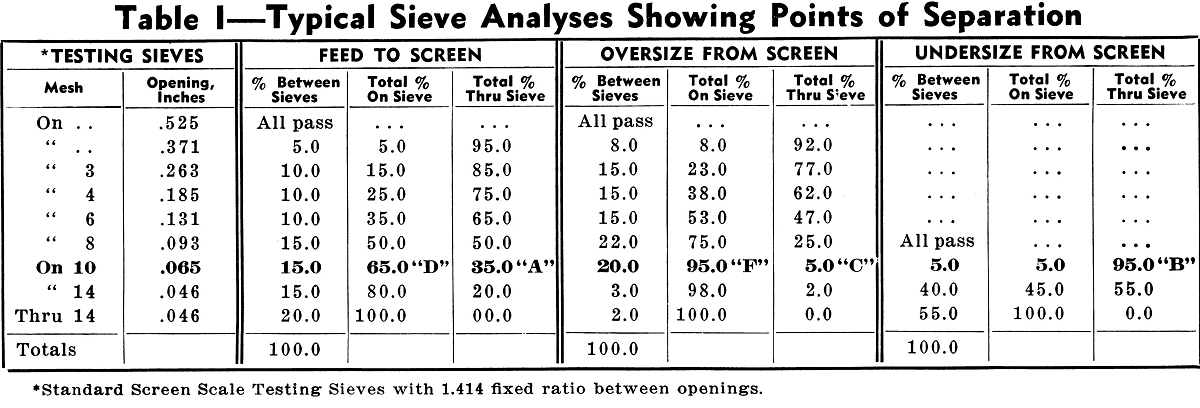
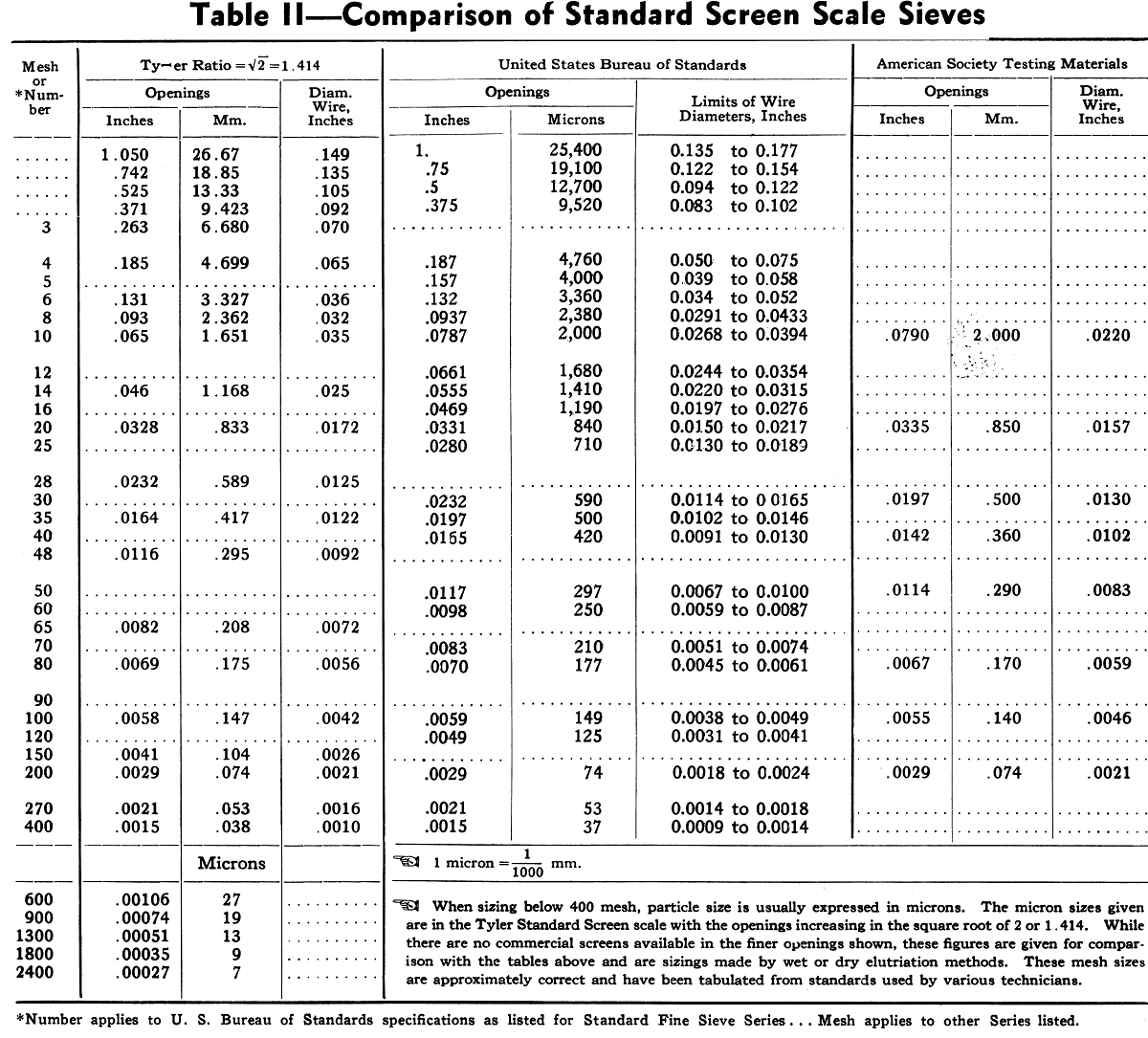
Source: This article is a reproduction of an excerpt of “In the Public Domain” documents held in 911Metallurgy Corp’s private library.
